The Rise of AI Voice Cloning Explained | TrendydailyNews

Imagine hearing a deceased loved one’s voice reading a new story, or your favorite actor narrating your emails. Now, imagine receiving a scam call that perfectly mimics your boss’s voice authorizing a wire transfer. This is the reality being ushered in by AI voice cloning technology, a field advancing at breakneck speed, sparking both wonder and widespread alarm.
From entertainment innovations to sophisticated fraud schemes, the ability to synthesize incredibly realistic human voices from just seconds of audio is no longer science fiction. At TrendydailyNews.com, we delve into the cutting edge, and AI voice cloning is a trend demanding attention – not just for its capabilities, but for its profound ethical and security implications.
How Does AI Clone a Voice? (The Simple Version)
While the underlying technology (often involving deep learning models like generative adversarial networks or transformers) is complex, the basic idea is training an AI on a target voice sample. The more audio data the AI receives, the better it learns the unique nuances – pitch, tone, cadence, accent – of that individual’s speech. Modern tools can now achieve startlingly accurate clones with remarkably small audio samples, sometimes just a few seconds scraped from online videos or recordings.
Key players and platforms are emerging rapidly, offering services ranging from professional voiceover generation to more accessible (and potentially abusable) tools.

The “Wow” Factor: Potential Benefits & Creative Uses
The legitimate applications are compelling and are driving interest:
- Entertainment: Creating realistic voiceovers for documentaries, video games, or even “resurrecting” the voices of historical figures or deceased actors (with permission).
- Accessibility: Giving a unique, personalized voice to those who have lost their own due to illness or injury, powering text-to-speech applications.
- Personalization: Customizing digital assistants or creating personalized audio messages.
- Education: Developing more engaging learning materials with varied and realistic narration.
- Content Creation: Allowing creators to easily generate voiceovers without expensive recording equipment or hiring actors. ([Link to potential TND article about Creator Economy Tools])
The Dark Side: Scams, Misinformation, and Ethical Nightmares
The potential for misuse is immense and deeply concerning:
- Sophisticated Scams: Fraudsters using cloned voices of family members or authority figures to trick people into sending money or revealing sensitive information (vishing).
- Misinformation & Propaganda: Creating fake audio clips of politicians or public figures saying things they never said to manipulate public opinion or incite conflict.
- Identity Theft & Harassment: Using someone’s cloned voice for malicious purposes, including harassment or creating deepfake audio for extortion.
- Copyright & Consent Issues: Unauthorized cloning of celebrity or voice actor voices, undermining their livelihoods and violating their rights.
- Erosion of Trust: The proliferation of fake audio makes it harder to trust what we hear, potentially devaluing genuine recordings. ([Link to potential TND article about Cybersecurity or Online Safety])
Navigating the Uncharted Territory
The rapid development of AI voice cloning is outpacing regulation and societal norms. Key questions remain:
- Who owns a voice?
- What constitutes fair use versus infringement?
- How can we reliably detect cloned audio?
- What safeguards are needed to prevent malicious use?
Technology companies, regulators, and the public are grappling with these challenges. Solutions might involve watermarking synthetic audio, developing better detection tools, and establishing clear legal frameworks around consent and usage.
The power to replicate a human voice is transformative. While AI voice cloning offers exciting possibilities, its potential for harm requires urgent attention and responsible development. Understanding both sides of this technology is crucial as it becomes increasingly integrated into our digital world. ([Link to TND Technology category page])
FAQ Section
Q1: How much audio is needed to clone a voice?
A1: It varies by technology, but some state-of-the-art AI models can create a reasonably convincing clone with just a few seconds of clear audio. More audio data generally leads to a higher-fidelity clone.
Q2: Can I tell if a voice is AI-cloned?
A2: It’s becoming increasingly difficult. While some early clones had artifacts or sounded slightly unnatural, the best current models can be virtually indistinguishable from the real person to the human ear. Detection software is being developed, but it’s an ongoing race against the cloning technology.
Q3: Is it legal to clone someone’s voice?
A3: Laws are still evolving and vary by jurisdiction. Generally, cloning someone’s voice without their explicit consent, especially for commercial use or malicious purposes, raises serious legal issues related to privacy rights, publicity rights, copyright, and fraud.
Q4: What can I do to protect myself from voice cloning scams?
A4: Be skeptical of urgent requests for money or sensitive information, even if the voice sounds familiar. Try to verify the request through a different communication channel (e.g., call back on a known number, send a text). Consider establishing a “safe word” with close family members for emergency situations. Report suspected scams to relevant authorities.


